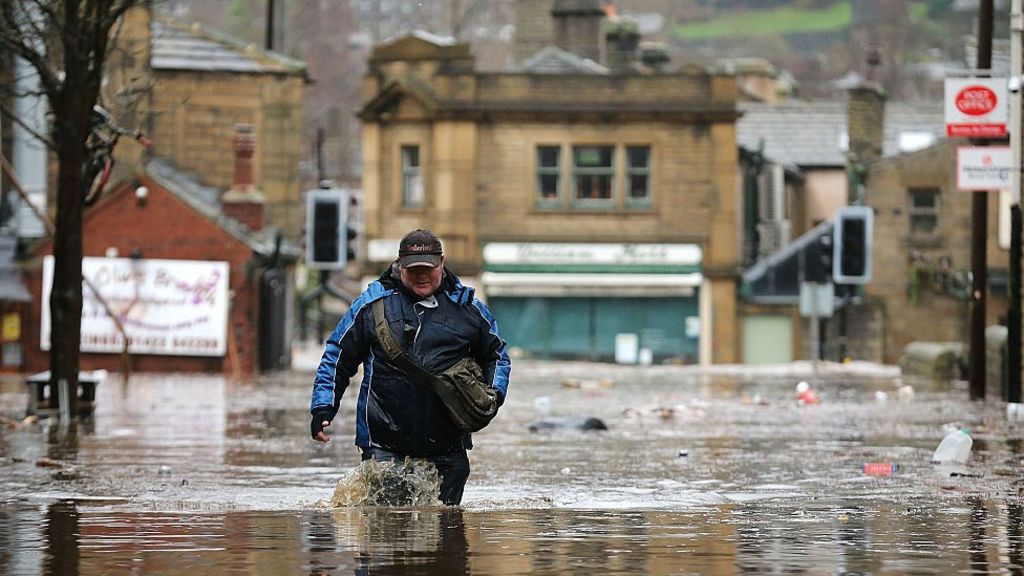Basic flood protection ‘missing in high risk areas’ – BBC News

 Image copyright Getty Images
Image copyright Getty Images Hundreds of thousands of householders in flood risk areas have failed to install basic protection against rising waters, insurers say.
The Association of British Insurers said even buildings guarded by flood defences should have flood-proof doors in case embankments are over-topped.
The comments add to a complex blame game over responsibility for floods.
The insurers have been criticised by the Environment Agency for failing to protect inundated properties.
Local councils are also part of the melee – they want more cash for flood funding from the government, and more control of how it is spent. They are critical of the Environment Agency.
Ministers are in the fray too, as demands increase for tighter building standards to ensure at-risk homes are made more flood resistant.
Some of these tensions around flood policy are revealed in an unpublicised report to government that ministers plan to launch in coming weeks.
In the report, the Environment Agency blames insurers for failing to prepare for the increased threat of flooding.
The insurers, the agency says, should not simply re-instate flooded homes to their original state – they should ensure properties are resistant or resilient to future floods.
Emma Howard Boyd, who chairs the agency, says: “There is a disconnect between insurance reinstatement and resilient repair of property.
“Loss adjustors and builders do not understand the benefits of resilient measures.
“It is not clear that the insurance industry value property-level resilience or incentivising people to have it.”
That is despite research suggesting that precautionary measures are extremely good value.
The report’s main author, Sir Peter Bonfield, points the finger at householders for failing to improve their homes after flooding.
He says: “The typical range of [flood-proofing] measures have a cost-benefit ratio in excess of 5 for every 1 invested in terms of reduced damages.
“However, there is still relatively low uptake in England – people at high flood risk aren’t routinely installing resilience measures in their homes and businesses.”
Sir Peter also says ministers may need to tighten building regulations to ensure that at-risk homes are properly protected – say, by raising plugs, fuse boxes and damp-proof courses.
This demand is supported by the Local Government Association (LGA). The organisation also wants a bigger budget for dealing with flooding.
The LGA also is privately critical of the performance of the national flood protection programme run by the Environment Agency – and wants it devolved to local areas.
Grants available
Meanwhile, the insurers are also frustrated that so many people have not taken responsibility for their own homes. Grants of up to 5,000 are available from government to flood-proof properties – but only if they have already been flooded before.
 Image copyright Getty Images
Image copyright Getty Images An ABI spokesman told BBC News: “Across the UK there are potentially hundreds of thousands of home and business owners who would really benefit from installing resistance or resilience measures at their property.
“Some of those will be protected by [public] flood defences, but we think there’s definitely an argument for people thinking, ‘In the eventuality that I do flood, what measures can I take myself to better protect my property at a property level – or help me recover quicker?'”
Another ABI spokesman told BBC News the criticism that it failed to future-proof flooded properties was unfair: “”The primary role of insurers after a flood is to help get people and businesses back on their feet.
“They encourage action to reduce the likely impact of future floods – by increasing consumer understanding of risk, urging the government to invest in defences and by supporting property-level resistance and resilience measures.”
Finally, there remains the public. Comments made to me on trips to flood-hit areas in Devon and Cumbria suggest many reasons why owners of at-risk homes and businesses do not flood-proof their properties.
They include: distrust of builders; inability to get grants unless they have already been flooded; dislike of form-filling; uncertainty about flood protection products; complacency about future flooding; lack of help from insurance companies or simply (and in many cases most powerfully), they can’t get round to it.
Follow Roger on Twitter: @rharrabin
Read more: http://www.bbc.co.uk/news/business-37565462